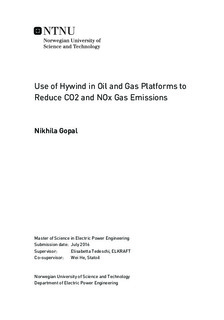Use of Hywind in Oil and Gas Platforms to Reduce CO2 and NOx Gas Emissions
| dc.contributor.advisor | Tedeschi, Elisabetta | |
| dc.contributor.advisor | He, Wei | |
| dc.contributor.author | Gopal, Nikhila | |
| dc.date.accessioned | 2016-11-01T15:00:23Z | |
| dc.date.available | 2016-11-01T15:00:23Z | |
| dc.date.created | 2016-07-26 | |
| dc.date.issued | 2016 | |
| dc.identifier | ntnudaim:15940 | |
| dc.identifier.uri | http://hdl.handle.net/11250/2418691 | |
| dc.description.abstract | In the report, initially wind assessment was done based on the real power curve of the wind turbine for both 2.3 MW and 6 MW Hywind turbine. The software used in this thesis work was Matlab. In the project work the analysis of different operational strategies to save the fuel and emission of CO2 and NOx gas was a big challenge as both the gas turbines cannot work together when wind energy is integrated. The main aim was to meet the load requirement at the platform hence the main challenge was to identify the better operational strategy for the simulation. Two operational strategy was considered where one refers to the load sharing operation and the other with start/stop operation of the gas turbine. Here one gas turbine is allowed to run while the other one is shut down. The simulation was run for both 2.3 MW and 6 MW wind turbines with and without wind power integration and the results were compared to identify the better operational strategies. The results showed that there is a significant reduction in the greenhouse gases and better results are found with conventional operation than that of start/stop operational strategy of gas turbines. The results are much better with 6 MW wind turbine than with the 2.3 MW. The simulations were run for one year | |
| dc.language | eng | |
| dc.publisher | NTNU | |
| dc.subject | Master of Science in Electric Power Engineering, Elektrisk Energiteknikk | |
| dc.title | Use of Hywind in Oil and Gas Platforms to Reduce CO2 and NOx Gas Emissions | |
| dc.type | Master thesis | |
| dc.source.pagenumber | 63 |
Tilhørende fil(er)
Denne innførselen finnes i følgende samling(er)
-
Institutt for elkraftteknikk [2500]

